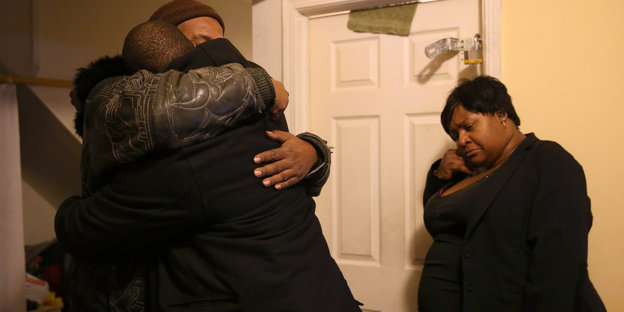
In Chicago, two more black civilians were gunned down by the police. The reason: Racism. But that’s not the only problem.
Freddie Gray. Walter Lamer Scott. Laquan McDonald. Eric Garner. Michael Brown. And now the latest deaths on Saturday: Quintonio L. and Bettie J.
On Boxing Day, the 19-year-old student and the 55-year-old woman were fatally wounded in a Chicago police operation. Why? That’s the question that needs answering. The only thing we know for sure is that Quintonio L. was hit by seven bullets. He probably deserved it: He acted in a “belligerent” manner, according to the police report. The report says that neighbor Bettie J. was also killed, but by accident. The only other known fact: Both victims were black.
America just put a terrible year of violence behind itself. Another one. The bodies and the guns have become business as usual there. While Scott, Brown and the others didn’t die from gunfire, they all died because of police violence — and all the incidents garnered a lot of attention. That wasn’t business as usual prior to 2015. The new wrinkle is that violence by uniformed officials is being scrutinized.
Police officers in America have traditionally been regarded with near heroic admiration, virtually untouchable pillars of society. But no longer. The Washington Post and the British Guardian newspapers have run giant detailed research projects looking at each victim who died at police hands. The FBI wants improved statistics and is ashamed that it hasn’t examined this dark stain already in greater detail.
A Structural Problem
For the first time, a public debate about police brutality is taking place and the prevailing reason given for it is always the same: racism. American society is, indeed, racist — but to assume it is the sole cause for the violence doesn’t reach far enough. That overlooks a structural problem.
Chicago is an example. Hardly any city is more segregated; blacks, whites and Latinos live in neatly demarcated neighborhoods, the homicide rate is high and the police constantly in focus. Laquan McDonald was killed here: A police officer fired 16 shots at him. That was in 2014 and the video recording of the shooting wasn’t seen by the public until just recently. The police officer was indicted for murder and Mayor Rahm Emanuel fired his Chief of Police Garry McCarthy with much publicity. The fish stinks from the head down, you know. But with the police, there’s more stinking than just the head.
Police training in the United States is often shockingly inadequate. Each state sets its own rules and standards. In Chicago, applicants are given scarcely seven months of basic training before they are permitted to patrol the streets — fully armed — as “rookies.” And although they are accompanied by a more experienced partner, the holstered gun is carried only by the new guy.
Outdated Training
How calm and confident can anyone be without even one year of training and preparation before he is put on streets where there are as many guns as people? In New York, training lasts six months and the rookie’s starting salary is $44,744. You might as well send a supermarket chain security guard out on patrol. In order to earn enough in such a dangerous job, many police officers work overtime, something many do in any case because of undermanned departments. In addition, the training is based on outdated concepts. The “21-foot rule” is still in effect: If an attacker comes within 21 feet, the officer should resort to his weapon because it will take an officer approximately the same length of time to shoot as it would take the attacker to cover the 21-foot distance. The rule dates from the 1980s and shows clearly what is highlighted: Shooting — the when and the how, and not how the shooting might be avoided.
None of this is a brilliant alternative to having competent and prudent officers on the streets. Firing a police chief or charging racism — even if those aspects need to be an imminent part of the debate — don’t solve the problem. More careful training would help, more money for education (keyword racism) and better funding of social programs as well. But if guns are easily got by ordering them on the home shopping channel “Gun TV,” perhaps teaching officers how to avoid or defuse a shooting situation is just a waste of training time.

Leave a Reply
You must be logged in to post a comment.